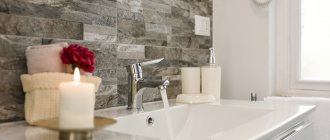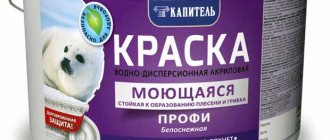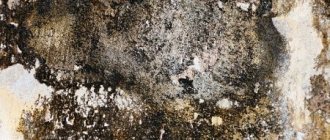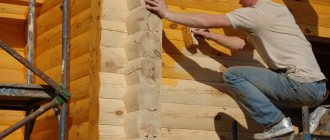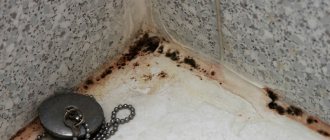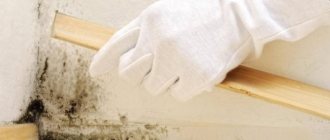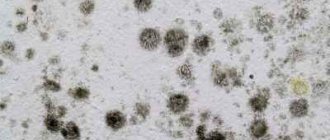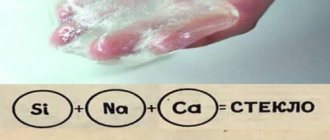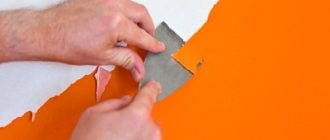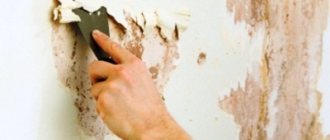- March 26, 2019
- Walls
- Marina Lobacheva
For various reasons, fungus may appear on the walls of an apartment. Its spores are dangerous to the health of every person. It is impossible to get rid of it with a standard wash, so you have to resort to some drastic and complex methods. Therefore, anyone who finds spores on the walls of their apartment should understand how to remove fungus from the walls so that such a problem does not arise again in the future. To do this, you can use different technologies and means.
Causes of fungus
Mold survives even in extreme conditions, so it can be difficult to completely get rid of. It most often forms in places with high levels of humidity, but it can appear even in a warm and well-ventilated apartment. In this case, the spores are in the air, settling on furniture, walls and other surfaces of the room. Then they multiply quickly, which is dangerous for people living in this room, so it is important to know how to remove fungus from the walls.
The main reasons for the appearance of fungus include:
- the room has a high level of humidity;
- During the construction of a residential building, cheap materials were used, which led to freezing of the walls in winter;
- the construction of the house was carried out by non-professionals, so they violated construction technology or some significant standards;
- Condensation occurs on plastic windows every day;
- the residents of the building insulated the windows in violation of certain rules;
- there is no ventilation system in the room;
- the presence of damp basements in an apartment building.
Initially, the property owner must determine the cause of the dispute, since if it is not eliminated, the fungus will still appear periodically on the walls of residential premises. The most common cause is excess moisture, which needs to be removed quickly. This often requires complex construction work. Only after this can you use various remedies against fungus on the walls.
Varieties
Fungi appear on different surfaces:
- brick;
- plaster;
- concrete;
- stone;
- tree;
- decorative finishing materials.
Main types:
- Blue mushrooms. They are characterized by a gray-blue color and greatly destroy the plaster, penetrating deeply into its pores.
- Mold fungi. Formed on concrete or painted surfaces. The fungus greatly destroys building and finishing materials and releases toxins.
- Mushrooms of decay. They affect wooden surfaces, completely destroying their structure.
Fungi penetrate deeply through plaster to brick walls within one year.
Mold is a type of mold fungus and is divided into:
- Black. It reproduces rapidly, and the intensity of its color depends on the stage of development. This type of mold is dangerous for people as it attacks the lungs.
- White. It occurs in basements, but is also found in residential buildings. Comfortable conditions for its reproduction are sudden temperature changes, high air humidity, and lack of daylight.
- Pink. It is not as dangerous as other types, but it is also worth getting rid of, as it destroys finishing materials and spoils their aesthetics.
Where does fungus usually appear?
You can identify several places in an apartment or house where mold occurs most often. These include the following areas:
- in wooden buildings it forms under the floor;
- in apartments, mold most often appears in corner rooms;
- in rooms with high levels of humidity, disputes arise very often, and such rooms include a bathroom or toilet;
- You can detect fungus in a room where the ventilation system is missing or not working properly.
Some people prefer to contact specialized companies to eliminate fungus because they are afraid that they themselves will not be able to cope with this problem. In fact, if you choose the right remedy for fungus on the walls, and also perform the procedure several times, you can easily eliminate all spores.
Before starting work, it is important to make sure that the room where mold was found will be constantly ventilated. Additionally, it is recommended to eliminate moisture and install a high-quality ventilation system.
Fire retardants for wood
Fire retardants or wood fire retardants are chemicals that protect wood and wood-based materials from exposure to fire.
Nomenclature of fire retardants:
| 1 | Fire retardant. 2nd group of fire retardant efficiency | MS(0-1) |
| 2 | Fire retardant. 1st group of fire retardant efficiency | |
| 3 | Fire retardant varnish. Fire protection and decorative finishing of wooden elements of premises | OZL-SK |
| 3 | Fire retardant transparent paint. Fire protection and decorative finishing of wooden building structures | Phoenix DP |
| 3 | Fire retardant white paint. Fire protection and decorative finishing of wooden building structures | Phoenix DB |
| 4 | Fire retardant white paint. Fire protection and decorative finishing of wooden building structures | Fire protection+ |
Consequences of the presence of fungus
Some people, even when mold is discovered, do not take any action aimed at completely eliminating it. This problem should not be ignored, since spores really have a negative effect on the human body. The consequences of the presence of fungus in residential premises include:
- problems appear with the respiratory system into which spores enter;
- if children or elderly citizens live in the apartment, they may develop allergies;
- If any resident has poor immunity, the fungus can cause serious infectious diseases of the skin or lungs.
Therefore, if mold is discovered, you should immediately begin removing it. Fungus on the walls in an apartment can be eliminated using different methods, but you need to do some preparatory work in advance.
Results
IMPORTANT! Do not despair if after the first application the mold does not disappear completely. Many products require several applications when the fungus is widespread.
In addition to the listed products, you can find a large number of analogues on the market that are not much inferior in quality. The main thing is to read the instructions before using the product and follow them to achieve a positive result.
Buy anti-mold product in the online store =>>
Preparation
Before directly using any methods or products to get rid of mold, it is recommended to do some preparation. To do this, the following actions are implemented:
- personal protective equipment is prepared, which includes gloves, a respirator and protective clothing, since aggressive chemicals are often used to eliminate mold, which can harm the skin or mucous membranes;
- To clean the base, a spatula and a metal brush are prepared;
- to wash the walls you need to prepare a bucket of warm water, as well as suitable rags;
- Additionally, a specialized product is prepared that will be used to eliminate spores, and it can be replaced with a household composition or a specialized chemical solution.
Sometimes people simply do not notice that they have black mold in their apartment. It can be located in corners under wallpaper, as well as in places where people rarely look. The presence of fungus can be determined by the unpleasant and rather pungent smell of dampness.
Antiseptics for wood
Antiseptics or antiseptic impregnations for wood are chemical preparations that protect wood from biological destruction (rotting, woodworm damage, mold, house fungi).
Nomenclature of antiseptics:
| 1 | Antiseptic paste. The best protection against house fungus | PAF-LST |
| 2 | Leave-in antiseptic for external use | XM-11 |
| 4 | Sanitizing antiseptic | HMF |
| 5 | Toning antiseptic | HMHA |
| 6 | Antiseptic for blue stains | BS-13 |
| 7 | Antiseptic “double protective shell” | HMBB |
| 8 | Antiseptic “multifunctional protection” | FBS |
Surface cleaning
The fight against fungus on walls begins with proper cleaning of the base. To achieve this, the property owner implements the following steps:
- Initially, the surface on which there is fungus is thoroughly cleaned with a metal brush and spatula;
- this area is then washed well with warm water, and during the procedure it is necessary to wear a respirator so that spores do not enter the lungs, as this can cause bronchial asthma;
- if the process is carried out in the bathroom, then usually the mold has to be cleaned out from the seams between the tiles, so you need to make sure that the coating fits tightly to the base, since sometimes the fungus leads to the destruction of building materials that will need to be replaced;
- Wallpaper from the affected areas must be removed, for which it is initially moistened and then scraped off with a metal spatula;
- stripping must be carried out to the concrete base;
- small roughness can be easily removed with sandpaper;
- if there are really significant lesions, you will have to completely remove the layer of plaster.
Sometimes during work it turns out that black mold has affected not only the walls, but also the ceiling of the room. In this case, cleaning and processing will have to be performed on all surfaces of this room. Removed wallpaper, plaster, ceiling coverings and other materials covered with spores are promptly thrown away. After this, the room should dry well, for which it is advisable to turn on the heat gun or heating if you have an autonomous boiler.
Only after completing all the preparatory steps can you resort to using various means to remove fungus on the walls in the apartment.
Ways to get rid of fungal infections on walls
You can get rid of mold. Not to say that this process is quite quick and easy, but you can get rid of fungus and mold. If you take timely measures, you can get rid of the problem without harm to your health.
For this you will need:
- remove the decorative covering, if any (wallpaper, stickers);
- the depth and area of the lesion are determined;
Reference! Fungal plaque can penetrate deep under the plaster coating and reach concrete walls.
- a layer of plaster is removed from the walls;
- all remnants of the coating are removed;
- mold is thoroughly cleaned off;
For this purpose, brushes with coarse bristles are used. If a metal brush is not available, you can use sandpaper.
Reference! The walls are first wetted with water. Next, the surface must be thoroughly dried with a hairdryer, and only then cleaning chemical compounds are used.
Using Home Remedies
It is allowed to use not only specialized chemical compounds, but even home remedies that allow you to destroy mold. How to remove fungus on the walls in an apartment? To do this, you can use the following available tools:
- hydrogen peroxide;
- vinegar;
- ammonia;
- copper sulfate;
- bleach;
- soda;
- tea tree oil.
In practice, it often turns out that the use of these products does not give the desired result, so even if it is possible to get rid of mold, it is only for a short period of time. Therefore, if there is serious damage to the walls, you need to use professional compounds.
Folk remedies for mold
The easiest way to treat walls is to use non-traditional means that are cheap and accessible. It is not recommended to remove large accumulations of fungus using these methods, since they are weaker (with the exception of copper sulfate). After the initial treatment, repeat treatments are done 7–10 days later.
Soda
Mold removal can be done using regular baking soda. This is a universal disinfectant that will not harm humans or pets.
Soda in the amount of a tablespoon should be diluted in a glass of water, then begin to treat the affected areas. The solution is poured into a sprayer, the walls and ceiling are irrigated. After an hour, you need to wash off the soda with water and wipe the base dry with a cloth.
Hydrogen peroxide
The product can be applied to walls in its pure form, without dilution. Peroxide does not produce harmful fumes, and the liquid is not toxic. You just need to be careful with wallpaper, because the solution has bleaching properties and can leave white spots on the surface after drying.
Peroxide can be used together with other components in the following recipe:
- take 4 parts water,
- add 2 parts vinegar, the same amount of boric acid,
- add 3 parts peroxide (3%),
- Apply to the fungus, leave for an hour, rinse.
Vinegar
Using vinegar helps against mold. Table vinegar is poured into a sprayer and the walls or ceiling are irrigated. Then rub with a cloth and leave for 2 hours. Then carefully wash off the vinegar from the surface.
Copper sulfate
Sold in packages in the form of dry powder. About 100 g of vitriol should be poured into a metal bucket, add 10 liters of warm water. Stir the mixture until the powder is completely dissolved. Pour the drug into a spray bottle and treat the affected areas of the apartment. You can use a foam sponge.
The solution should dry for 3 - 5 hours, then it is sprayed again on the same places, and so on up to 2 - 5 times. In advanced cases, you must first remove the putty and finishing material. It is not advisable to stay in the room for 3 days, then the fumes of copper sulfate will stop being released.
Laundry soap
Soap solution is a good antiseptic. Laundry soap is dissolved in water, then the walls are washed in a convenient way. After a couple of hours, wash off the remaining soap with water.
Ammonia
Ammonia can only be used on smooth, hard surfaces, and the product will be useless on porous substrates. Ammonia is mixed with water equally and sprayed onto fungus-damaged areas. Wash off with water after an hour.
Borax
Borax is a non-toxic product of natural origin that has powerful fungicidal properties. Destroys mold and prevents its reappearance.
Before using borax, you need to clean the surface with a vacuum cleaner so that fungal particles do not fly through the air. Then you should prepare the solution, observing the correct proportions.
Take a glass of borax from the bag and dilute it in 2.5 liters of water. The solution is applied to the base with a stiff brush, while simultaneously removing the fungus. The borax should be allowed to dry completely; there is no need to wash it off.
Bleach
Many bleaches contain sodium hypochlorite or other forms of chlorine (eg, Bleach). This additive is very effective against mold and can even replace professional fungicidal preparations.
Bleach is used only on surfaces that are white, otherwise it will not be possible to avoid unsightly stains and damage to the coating. Bleach can be used on tiles and glass, but it is not used on drywall and wood.
Due to its toxicity, working with chlorine must be done with caution. Protect your hands with gloves, and put a respirator on your face. Dilute the drug 1:10 with water and apply to damaged areas using foam rubber or a brush. After complete drying, the surface is cleaned and washed with water.
Other folk recipes
Tea tree oil is a natural antiseptic. Pour a teaspoon of oil into a glass of water and spray the walls and ceiling where the mold has settled. There is no need to rinse off the solution - the product is absolutely harmless to humans.
You can also treat surfaces against fungus using a solution of potassium permanganate. Pour ½ teaspoon of potassium permanganate powder into a liter of water, spray the walls or gently wipe them.
Some people use office glue for mold. It is diluted 1:1 with water, after which small areas with mold can be treated with the product.
Rules for using improvised means
If, nevertheless, the owner of a residential premises prefers to use home remedies for mold and mildew, then he must understand the rules for their use. To do this, the following nuances are taken into account:
- if there are only small affected areas, so the spores have not penetrated too deeply into the structure of the building material, then you can use ordinary hydrogen peroxide, represented by an oxidizing agent;
- peroxide has good antifungal and antiseptic characteristics, and is also odorless and does not contain harmful or toxic components;
- vinegar is a folk remedy for fighting mold, but it should only be used in a well-ventilated area, since it is a volatile material;
- vinegar does not need to be washed off after use, but to completely eliminate all spores, you will have to perform this treatment twice a week for several months;
- even soda has antifungal properties, so it is sometimes used by citizens if small children live in residential properties, but to completely eliminate the fungus, the treatment will have to be repeated very often;
- sometimes bleaches are used to eliminate the problem, but first you should make sure that they contain sodium hypochlorite, since it is this component that has antifungal properties;
- Tea tree oil is a natural antiseptic, so it is advisable to use it only on wooden surfaces.
If you choose bleach for work, you only need to work with it wearing gloves, otherwise you will get burns on your hands. It is usually chosen for tiled surfaces. If a citizen understands how to remove fungus from the walls, then it is possible to completely destroy the spores in a short period of time without causing any harm to the residents.
What kind of fungus can live on walls?
The main types of fungal infections include:
- mold fungi. Concrete structures are most often affected;
- blue fungi. Most often spread on wooden surfaces;
- fungal rot. Rot is also divided into several types, the gradation of which occurs according to the color of the bacteria;
These are the main types of fungi that can infect various surfaces. Depending on the type of fungus, methods of combating it will be determined.
Choosing an antiseptic primer
The most effective method of combating mold is the use of a primer that has the necessary properties. Antiseptic for walls against mold and mildew allows you to quickly get rid of the problem, but you need to use it carefully. The procedure is carried out only in a ventilated area and with the use of protective clothing and a respirator. After completing the process, you need to wait a few days before moving into the property.
Antiseptics can be presented in different forms, so people are often faced with a difficult choice. The most popular product is Fongifluid Alpa. It is sold in many hardware stores, and also allows you not only to eliminate the fungus, but also to prevent its reappearance. Additionally, the Olympus Stop Mold product is often purchased. It must be applied in two layers, and it can be used even in particularly damp rooms, such as basements or cellars.
Features of using these funds include:
- they are sold ready-made, so they are very easy to use;
- applied to the contaminated surface with brushes or a spray;
- Before application, it is important to properly prepare the walls, which need to be freed from finishing materials and thoroughly cleaned.
Immediately after this professional product has dried, you can begin finishing the surfaces, so there is no need to repeat the procedure several times.
Special remedies for fungus
Most manufacturers of building mixtures and paints and varnishes produce various anti-fungal products. It is important to describe the problem to a specialist so that the employee can help you choose a remedy suitable for a specific type of mold. Solutions must match the material to which they will be applied and not spoil it.
The most popular solutions:
- Atlas Mykos - sold in the form of a concentrate, can be used for interior and exterior use, including on mineral surfaces.
- Spectrum - used on wood, putty, painted surfaces, and at high humidity.
- Teflex is an environmentally friendly product that can be applied to walls in a child’s room.
On the walls you can use Antisept, Abedis, Xiolat, Snezhka Impregnation.
Antiseptics in solutions
Typically, solutions are used when the area affected by the fungus is quite large. The drugs are sold in large containers - jars, canisters, and have a ready-to-use form. The concentration of the solutions is safe for humans.
They are applied with a sponge, erasing most of the mold. Usually 1-2 treatments are enough to get rid of the fungus, but then for prevention you can add the product to the water for cleaning the room.
List of the best solutions with fungicidal additives:
- Dali,
- Fongifluid Alpa,
- Olympus Stop mold,
- Biotol,
- Mavix-Bio.
Primers - antifungal
Primers can be used to carry out treatment even at the stage of construction or repair. Good products are sold in any specialized stores; almost every brand of building materials has them. Excellent quality is observed in the soils Milkill (MilKill), Terragrunt, Kremen, Lakra, Auburn.
Most products have the ability to penetrate deeply into the pores of the base. Anti-mold components are introduced into the smallest crevices of concrete, and other substances fill the pores from the outside. To avoid problems with mold for a long time, it is better to treat any surfaces during repairs with similar soils.
Ammonia
Another remedy for fungus on the walls of a bathroom or other room is ammonia. Its characteristics are similar to bleach. It is advisable to use it if there is fungus on any solid and non-porous substrates. If the walls are made of foam blocks, then it is advisable to choose some other solution to eliminate mold spores.
Most often, ammonia is used when fungus is detected on a tile or glass surface. To use it, you need to mix it with water in equal proportions. It is advisable to spray it over the surface and then wait about one hour. Next, the product is washed off and the room is thoroughly ventilated. The work should be done carefully, as alcohol has a strong and pungent odor that causes dizziness, headaches and other unpleasant symptoms.
Water repellents
Water repellents are designed to protect artificial and natural stone, brick, concrete, expanded clay concrete, aerated concrete and other building structures and materials from exposure to water. Giving hydrophobic (water-repellent) properties to building materials. Protection of antiseptics from leaching.
Range of water repellents:
| 1 | Water repellent (composition) | GKZh-11 |
| 2 | Water repellent (concentrate) | GKZh-11 |
Water repellent GKZh-11 is supplied in the form of a ready-made working solution - Composition GKZh-11 or in the form of a concentrated liquid - Concentrate GKZh-11. The working solution is prepared at the point of consumption by mixing the concentrate with the appropriate amount of water.
Antiseptics, flame retardants and fire-retardant preparations for wood protection can be used either independently or in combination with other preparations and painting compositions. Antiseptics and fire retardants that protect wooden structures from biological agents of destruction do not protect them from solar radiation, wind erosion, or mechanical damage. Creating a protective film on the surface of wood from painting compounds partially solves this problem, and the combined use of antiseptics, fire retardants and painting compounds in the widest range solves the issue of protecting wooden structures from destructive factors. After impregnation of wood with preparations (except PAF-LST), the wood is easily glued and painted.
Let's consider various areas of application of antiseptics, fire retardants and fire protection agents when processing wooden building structures:
Grapefruit seed extract
Using this method is similar to using tea tree oil. To purchase this product you will have to spend quite a lot of money. The extract does not have any odor. It has good disinfectant properties.
It is quite easy to prepare the solution, since only 10 drops of this substance are required for one glass of clean water. It is advisable to apply the resulting mold and mildew remedy to the walls using a sprayer. After completing this work, there is no need to wash off the extract from the surface. This method is effective, and the product used protects the room from the appearance of fungal spores in the future.
Preparations for internal use
To protect wood from damage by mold, wood-staining, wood-destroying fungi and wood borers:
- walls from inside the house,
- partitions,
- roof structures (rafters, sheathing),
- interfloor and attic floors
antiseptics based on borrates are used: BB-11, KhMBB, , FBS.
At the same time, the preparations BB-11, BS and wood impregnated with them are the safest for humans and warm-blooded animals, and the FBS antiseptic provides multifunctional protection of wooden structures from a wide range of biodegradation.
Potassium permangantsovka
Even ordinary potassium permanganate can be used to eliminate mold. How to remove fungus from walls using this product? To do this, initially make a weak solution of potassium permanganate, for which only 1 teaspoon of potassium permanganate is used per 1 liter of water.
The resulting composition is distributed evenly over the infected surface, for which it is advisable to use a sprayer. Additionally, you can wipe all the walls with a rag soaked in this solution. It is allowed not to wash off the potassium permanganate to enhance the effect.
Anti-mold "Teflex"
Not only folk methods can eradicate the problem, industrial options will also help cope with it. For example, Teflex. The advantages of this tool can hardly be overestimated. It is used not only for domestic purposes, but also at the construction stage - in industrial ones. It can be used to impregnate any materials: concrete, brick, wood. Thus, even before the appearance of the fungus, prevention is carried out. However, the manufacturer does not exclude the possibility of using it at all stages of construction. It can be added to paint and treated surfaces.
Aroma oils
You can even use aromatic oils to fight fungus. Rosemary or lavender oil is chosen for this. These products include agents that kill mold. For high-quality processing, the following actions are performed:
- Initially, a solution is prepared by adding just a few drops of purchased oil to a glass of water;
- Using a sprayer, the composition is applied to the entire surface of the wall where the fungus was found;
- the solution does not have an unpleasant odor and does not contain harmful chemicals;
- The oil perfectly fights mold and prevents its further spread.
You can buy suitable oil in specialized stores, and the cost of a small bottle is considered acceptable.
Stationery glue
Sometimes citizens even use ordinary office glue to eliminate fungus. To do this, it is diluted in equal proportions with water, after which it is applied with a brush to the walls of the room.
This method is considered not very effective, since the substances contained in the glue can only fight certain types of mold, so they do not always cope with eliminating the fungus. Additionally, you should not use this method to treat a large affected area.
Lemon acid
The fungus can be destroyed even with regular citric acid or lemon juice. These products have unique antifungal properties, since they contain organic acid.
To obtain the optimal solution, add a teaspoon of citric acid to a glass of water. This composition is then used to treat the wall, and can also be used for tile covering.
Prevention of fungus
To avoid the need to combat mold, it is recommended to use some recommendations to prevent its occurrence in residential premises. To do this, you need to know how to get rid of dampness in an apartment. Therefore, the following tips are taken into account:
- Each room must have a high-quality ventilation system;
- the bathroom and other rooms with high humidity should be regularly ventilated;
- all interior items should be positioned in such a way that air circulates freely;
- during repair or finishing work, it is important to ensure that any applied material is completely dry before starting the next stage;
- for construction or repair it is recommended to use different compositions and products containing antiseptic components;
- if even one small black spot appears, it must be promptly removed, since in this case the problem can be dealt with even with folk remedies;
- Particular attention should be paid to the bathroom and toilet.
If you initially ensure that the humidity in the rooms is not too high, this will guarantee the absence of fungus in the living rooms.
Rules and conditions for fungus removal
To effectively combat the problem and remove the fungus forever, you need to influence its causes. It is not enough to treat the walls once - a major overhaul will help here. Finishing materials must be removed from the walls, otherwise the fungus will spread further.
Furniture, interior items, belongings, equipment, clothes are removed from the room being repaired, and if possible, everything is disinfected. Textiles and items are washed at a temperature not lower than +60 degrees with powder. Furniture is wiped with antiseptics.
